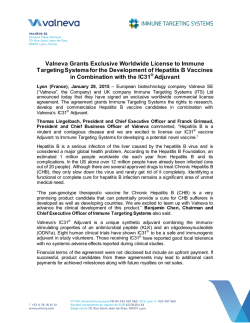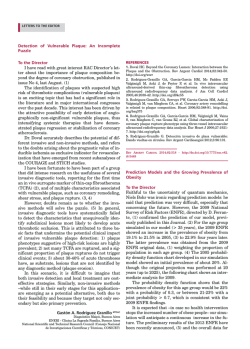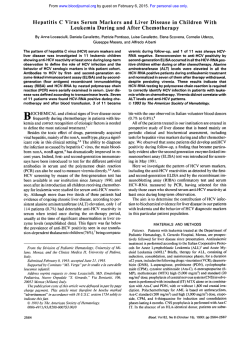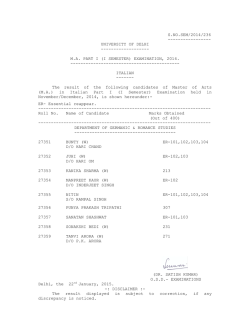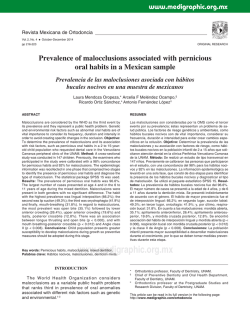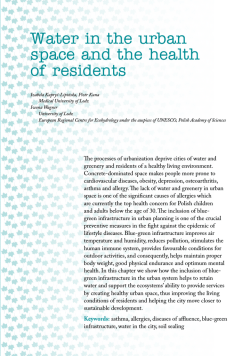
Download [ PDF ] - journal of evolution of medical and dental sciences
DOI: 10.14260/jemds/2015/203 ORIGINAL ARTICLE A DEMOGRAPHIC STUDY OF HEPATITIS B IN HEALTHY POPULATION OF CENTRAL INDIA Uday Raj Singh1, S. K. Mishra2, Gajendra Pal Singh Uike3, Amar Bahadur Singh4 HOW TO CITE THIS ARTICLE: Uday Raj Singh, S. K. Mishra, Gajendra Pal Singh Uike, Amar Bahadur Singh. “A Demographic Study of Hepatitis B in Healthy Population of Central India”. Journal of Evolution of Medical and Dental Sciences 2015; Vol. 4, Issue 09, January 29; Page: 1440-1448, DOI: 10.14260/jemds/2015/203 ABSTRACT: BACKGROUND: In central India (M.P.) there is high prevalence of hepatitis; of which hepatitis B contributes as a major cause of hepatitis. In our area there were no major efforts to contain the disease. According to one estimate most of the hepatitis B occurs due to negligence transfusion of infected blood (Hepatitis B). Therefore we have tried to found percentage of population infected with this disease. MATERIAL AND METHODS: Study design – Prospective study. For screening donors we have used one step rapid test for the detection of HBsAg and confirmatory test was done by ELISA method. Statistical Analysis Statistical analysis was done by using Minitab 17 Pennsylvania, USA. RESULTS: In our study we found 2.8% HBsAg infected blood among healthy donors; which was significantly (P < 0.05) more in voluntary donors in comparison to replacement donors. Male between age groups 39-48 were found highly infected in comparison with other age groups. We also found prevalence was highest in Hindu community (2.9%) and more in working group (3.9%) in comparison to students and farmers. CONCLUSION: For effective control of transfusion of infected blood and to prevent its spread, we have to improve community knowledge towards vaccination; educational programs for blood bank personals; and government should open blood banks at Community Health Center level. KEYWORDS: Prevalence of Hepatitis B, blood transfusion associated infection screening of hepatitis B. INTRODUCTION: Hepatitis is term to describe a nonspecific liver inflammation. Liver is the largest and most complex internal organ of human body. It performs wide range of functions ranging from detoxification of hormonal substances to synthesis of various products. Naturally liver is vulnerable to a wide variety of insults- metabolic, inflammatory, toxic, microbial, circulatory and neoplastic. Among the patients suffering from liver diseases, viral hepatitis is a common clinical condition.1 Viral hepatitis has been a part of recorded history since the time of Hippocrates (Bockus Gastroenterology, 5th Edition) for centuries; epidemics of hepatitis have devastated military and civilian communities throughout the world.2 Initially transmission of disease was attributed to nonparenteral routes, such as person to person contact or exposure to contaminated food or water. This was known as epidemic (infectious) hepatitis.3 However in 1885, in Bremen, Germany significant event occurred. Nearly 200 shipyard workers become jaundiced several months after vaccination against small pox with human lymph. Also there was no jaundice recorded in unvaccinated persons. This suggested another mode of transmission of disease with long incubation period and by parenteral route (Lurman 1885).4 Over the next century viral hepatitis was classified into two diagnostic categories- one infectious hepatitis and another serum hepatitis. Later on the names ‘Hepatitis A’ and ‘hepatitis B’ for serum hepatitis were proposed (Mac Callum, 1947).5 J of Evolution of Med and Dent Sci/ eISSN- 2278-4802, pISSN- 2278-4748/ Vol. 4/ Issue 09/Jan 29, 2015 Page 1440 DOI: 10.14260/jemds/2015/203 ORIGINAL ARTICLE No further progress in the knowledge of viral hepatitis was made until 1965, when Blumberg in Philadelphia, discovered an unusual antibody in the serum of hemophilics, who had received multiple blood transfusions. This antibody reacted with sera of an Australian aborigine but not with variety of sera from other people. Blumberg et al, therefore named this antigen present in sera of Australian aborigine as ‘Australia antigen’ This antigen is now known as the Hepatitis B surface antigen (HbsAg).6 Years later in 1973, Feinstone et al discovered hepatitis A virus, the agent responsible for infectious (Epidemic) hepatitis.7 The majority of cases of hepatitis until 1975 were attributed to either HAV or HBV. But still there were some cases of hepatitis particularly post transfusion hepatitis, which could not be accounted for by either of these viruses. And to explain these cases name of “Non A, non B hepatitis (NANBH) was proposed by Feinstone in 1975.8 In 1977 another breakthrough occurred when Rizzetto identified another virus responsible for viral hepatitis and named it as Delta agent (Hepatitis D virus). This virus was an incomplete virus because it was responsible for transmission of the blood borne type of hepatitis in combination with HBV only and not individually.9 Initially the diagnosis of Non-Non-B hepatitis was made by excluding HAV and HBV infections. This led to the search of causative agent of NANBH. Various studies revealed that NANB agent is not a single virus but different viruses responsible for different types of NANBH. These cases were then identified by Balayan10 (In Russia, 1983) and Houghton.11 (In USA, 1988) as to be caused by two different viruses, HEV and HCV respectively. Balayan isolated hepatitis E virus responsible for water-borne NANB hepatitis and Houghton isolated hepatitis C virus causing blood-borne NANB hepatitis. Later in 1989, Choo et al cloned the hepatitis C virus.12 The study has been undertaken to find out the prevalence of hepatitis B surface antigen & hepatitis C virus infection in the blood donors attending the blood bank of Gandhi Memorial & Sanjay Gandhi Memorial Hospital, Rewa associated with department of Pathology Shyam Shah Medical College Rewa (M.P.). MATERIAL AND METHOD: This study was carried out to assess the prevalence of HBsAg infection among the blood donors, who are attending blood bank for blood donation; by detecting antibodies to HBsAg in their blood firstly by rapid kits and confirmed by ELISA method. The blood donors (voluntary/replacement) attending the blood bank of Sanjay Gandhi Memorial Hospital, Rewa were selected. This study was carried out from September 2013 to June 2014 in the department of Pathology, S.S. Medical College, Rewa (M.P.). In our study 5281 samples were collected and screened for the presence of antibodies to HBsAg by rapid chromatographic immunoassay test strips (HEPAVIEW HBsAg QUALPRO DIAGNOSTICS, TULIP GROUP, GOA, INDIA). The reactive samples are further confirmed by Enzyme Linked Immunosorbent assay (Micro screen HBsAg ELISA KIT, Span Diagnostics Limited, SURAT, GUJARAT, INDIA). Methodology of HBsAg One Step Rapid Kit Test (According to manufacturer’s instruction) Rapid test kit for HBsAg is an in –vitro immunochromatographic, one step assay designed for qualitative determination of HBsAg in human serum or plasma. This test cassette contains a membrane strip, which is pre - coated with mouse monoclonal anti – Hbs capture antibody on test band region. The mouse monoclonal anti – HBs – colloid gold conjugate and serum sample moves along the membrane chromatographically to the test region ( T ) and forms a visible line as the J of Evolution of Med and Dent Sci/ eISSN- 2278-4802, pISSN- 2278-4748/ Vol. 4/ Issue 09/Jan 29, 2015 Page 1441 DOI: 10.14260/jemds/2015/203 ORIGINAL ARTICLE antibody-antigen reaction resulting in the formation of pink/purple colour line on the test region which confirms the presence of HBsAg. The test cassette has a letter of “T” and “C” as “Test Line” and “Control Line” on the surface of the cassette. Methodology of Microwell ELISA Method for HBsAg: Principle: The test is based on solid phase microplate direct ELISA (Sandwich ELISA) technique. The microwells are coated with mouse monoclonal anti-HBsAg antibodies. When patient’s sample is added, if HBsAg is present in the sample, it gets bound to immobilized anti-HBsAg antibodies. After removal of non-specific antigens, peroxidase labeled anti-HBsAg antibodies are added, which bind with immobilized antibody-antigen complex. After incubating and washing. TMB (Tetramethyl benzidine) substrate is added, which gives blue coloured product due to enzymatic activity. In absence of HBsAg, the colour will not change from its original pink colour. The reaction is stopped by addition of stopping reagent, which converts the blue color to end point yellow color. In a negative test, original pink colour as seen in the above step will now become colourless. The absorbance of yellow colour is directly proportional to the concentration of HBsAg present in patient’s sample. It is measured by microwell plate reader having 450nm as primary filter and 630nm as reference filter. PROCEDURE: (According to manufacturer’s instruction) Bring samples and all the reagents except color reagent and conjugate to room temperature before starting the procedure: 1. Dispence 100µl of sample Diluent to required number of wells except Blank well. ( leave Blank well empty) 2. Add 100 µl Negative control to B, C, D, and 100 µl Positive controls to E, F. Add 100 µl of Samples to rest of the wells, pipette up and down for mixing, seal strips securely with Adhesive strip covers. 3. Incubate for 60 minutes at 370C. 4. Remove and discard the Adhesive strip cover. Decant the content of wells into waste container. Fill the wells with approximately 350 µl of Diluted washing Buffer and allow soak time of 30 seconds (programme the auto washer for soak time of 30 seconds) and then decant it in the waste container. Repeat the washing steps for 4 more times. Drain wells on a disposable absorbent pads or towels and tap firmly to remove excess of water. 5. Add 50 µl of Conjugate Stabiliser followed by addition of 100 µl Conjugate to each well except A (Blank well). Mix the contents of microwells by agitating the strips gently for 5-10 seconds and seal strips securely with Adhesive strip covers. 6. Incubate for 30 minutes at 370C. 7. Repeat step 4 for washing. 8. Add 100 µl of colour reagent to the all the wells including Blank well. Seal strips securely with adhesive strip covers. 9. Incubate for 30 minutes at room temperature in dark. 10. Remove and discard Adhesive strip cover and add 100 µl of stopping solution to each well. Mix the microwells by agitating the strips gently for 5-10 seconds. Blue color of Positive control/ reactive samples will turn to yellow on addition of stopping solution. 11. Read the absorbance within 30 minutes with microwell plate reader using 450nm as primary filter and 630nm as reference filter after blanking with A well(reagent well) and calculate the results. J of Evolution of Med and Dent Sci/ eISSN- 2278-4802, pISSN- 2278-4748/ Vol. 4/ Issue 09/Jan 29, 2015 Page 1442 DOI: 10.14260/jemds/2015/203 ORIGINAL ARTICLE ETHICAL CLEARENCE: Ethical clearance was taken by institutional ethical committee Shyam Shah Medical College Rewa (M.P.) written consent was taken by all patients and donors, involved in the study. STATISTICAL ANALYSIS: Statistical analysis was done by using Minitab 17 Pennsylvania, USA. For non-parametric data chi – square test was done. P- Value <0.05 has taken as significant for all analytical studies. RESULTS Type of Donor No. Voluntary Donor 4431 HBsAg Prevalence Positive Cases % 137 3.0 Replacement Donor 850 14 1.6 Total 5281 151 2.8 Table 1 : Prevalence of HBsAg according to type of donor Statistical Inference for HBsAg: Chi-square test between voluntary and replacement donor X2 = 6.1 and p = 0.013 (Difference is significant since <0.05) Table 1 shows the prevalence rate of HBsAg was 2.8%. The voluntary donors accounting 3.0 % prevalence which is significantly ( p< 0.05) more than replacement donors having 1.6% of prevalence. 4623 HBsAg Positive Cases 143 Prevalence % 3.0 Female 658 8 1.2 Total 5281 151 2.8 Gender No. Male Table 2 : Prevalence of HBsAg Positive cases according to gender Table 2 shows overall prevalence rate of HBsAg infection in male and female was 2.8%. The prevalence rate of HBsAg in Male (3%) was higher than Female (1.2%). Age Groups HBsAg Positive Cases Prevalence % Male Female 18-28 32 21.1% 31 1 29-38 43 28.4% 40 3 39-48 49 32.4% 47 2 49-58 27 17.8% 25 2 Total 151 100% 143 8 Table 3 : Prevalence of HBsAg according to Age Range J of Evolution of Med and Dent Sci/ eISSN- 2278-4802, pISSN- 2278-4748/ Vol. 4/ Issue 09/Jan 29, 2015 Page 1443 DOI: 10.14260/jemds/2015/203 ORIGINAL ARTICLE Table 3 shows prevalence of various age groups in donors. The prevalence of HBsAg in age group range between 18-28 years was 21.1%, 29-38 years was 28.4%, 39-48 years was 32.4% and 49-58 years was 17.8%. The prevalence of HBsAg was higher in age group 39-48 years it was 32.4%. Occupation No. HBsAg Positive Cases Prevalence % Working 1940 77 3.96 Student 1673 49 2.9 Farmer 912 8 0.87 Others 756 17 2.24 Total 5281 151 2.8 Table 4 : Prevalence of HBsAg according To Occupation Table 4 shows the prevalence of HBsAg in donors based on their occupation. The prevalence of HBsAg in working population was 3.96%, in student it was 2.9%, in farmer it was 0.87%, and in others (laborer, house- wives etc.) it was 2.24%. Higher prevalence was found in working population. In our study it was also found that the prevalence of HBsAg in Hindus was 2.9 % and in Muslim it was 1.6% where as in others it was 0%. DISCUSSION: The present study was done on 5281 healthy blood donors attending the blood bank Sanjay Gandhi Memorial Hospital, Rewa from September 2013 to June 2014 were selected. First they screened with rapid card test; donors who show reactivity are further tested with ELISA 3rd generation. The overall prevalence of HBsAg infection was 2.8 %. In India, various studies have been done to determine prevalence of HBsAg with other blood bore diseases. On blood bank healthy blood donors studies; the overall prevalence of HBsAg ranges between 0.063 to 3.51%. Thus, prevalence observed in our study was within the range of national prevalence rate. Results obtained by various workers in India have been shown in the tables along with results of the present study. SL. No. 1 2 3 4 Author Year Riddhi Jaiswal et al13 Karandeep singh et al14 Yedlapati Bhawani et al15 Nagarekha Kulkarni16 19972005 200507 200409 200509 Place No. of cases Prevalence rate (%) GSVM Medical college Kanpur 1,15,073 1.7 Kasturba Medical college, Manipal 30,428 0.74 KIMS HOSPITAL(A.P.) 8,097 1.41 Vijayanagara Institute of Medical Sciences, Bellary Karnataka 19,135 0.063 J of Evolution of Med and Dent Sci/ eISSN- 2278-4802, pISSN- 2278-4748/ Vol. 4/ Issue 09/Jan 29, 2015 Page 1444 DOI: 10.14260/jemds/2015/203 ORIGINAL ARTICLE 5 6 7 8 9 Sayed A. Quadri et al17 R. Shyamala et al18 Sastry jayagowri Met al19 Nilima Sawke et al20 Dharmesh Chandra et al21 10 Nirali shah22 11 Present study 2010 2012 200813 200608 200913 2006 13 201314 Al Ameen Medical college, Bijapur 4,283 1.63 Bhaskar medical college Yenkapally Ranga Raddy District Charitable hospital blood bank in Pune People’s College Of Medical Sciences & Research Centre Bhopal 1,980 1.06 13,078 1.23 5,008 2.9 Gajra Raja,Medical College, Gwalior 67,132 3.51 Sheth V.S. General Hospital, Ahmedabad. 92,778 0.887 S.S.Medical College rewa 5281 2.8 Table 5 : Indian Studies (Hbsag Prevalence Rate in Blood Donors) The results of present study for HBsAg sero-prevalence was similar to findings made by Nilima sawke et al.20 (2006-08) from Bhopal; She studied 5008 blood donors ( Voluntary & Replacement ) from January 2006 to December 2008 at blood bank People’s College Of Medical sciences & Research Centre Bhopal by using ELISA kit and found a prevalence of 2.9% (149/5008). The HBsAg prevalence of 2.8% seen in present study is with in the range 0.063 – 3.51 according to Indian studies. Out of the various factors which need to be considered to explain this prevalence rate with other Indian studies are the epidemiology, demographic profile and social milieu of the region. No previous studies from this region are available for comparison. The nearest studies available from central India are by Nilima sawke ET al20 (2006-08) from Bhopal and from Dharmesh Chandra ET al.21 (2009-13) from Gwalior, which have reported prevalence rates 2.9% and 3.51% respectively. Second factor is the effect of study design especially the size of the sample population, type of the donor (Voluntary/ Replacement) and efficacy of the assay used. Riddhi Jaiswal et al13 studied for nine year from January 1997 to December 2005 screened with ELISA kit on 1,15,073 blood donors and found overall prevalence of 1.7% and found prevalence between male and female 1.64 and 1.57% respectively; but in present study it was 3.0 and 1.2 respectively. In present study it was higher because of different epidemiological region. In our study maximum donors presented in the age group 39-48 years (32.4%) for HBsAg prevalence. Similar findings was found by Sayed A. Qadri et al17 in 2013 at Bijapur karnatka (31.1%) but it was more in elder group that is 51-60 years. Fathi Abed A l-Gani23 in 2011 in Jordan found prevalence of HBsAg 33.3% also in elder group > 50 years. The cause of high prevalence in younger age in my study: 1. Low education level - This region is not having 100% literacy so not all population properly know about these infections and its complications. J of Evolution of Med and Dent Sci/ eISSN- 2278-4802, pISSN- 2278-4748/ Vol. 4/ Issue 09/Jan 29, 2015 Page 1445 DOI: 10.14260/jemds/2015/203 ORIGINAL ARTICLE 2. Un- hygienic habit – people using un-sterilized syringing, intra venous drug users because of more frequently used. 3. No vaccination by government to prevent it (Not included in national vaccination programs.) 4. Lack of proper screening facility before blood transfusion so that professional donors not excluded by screening. In our study we found that prevalence is more in working population (Employed population) in case of HBsAg (3.96%). Causes for high prevalence in employed and student Group: 1. Lack of proper awareness towards blood borne diseases. 2. Use of intra venous drugs by employed population and students. It’s emerging fashion among these groups. 3. Lack of motivational programs to discourage use of narcotic drugs. 4. There are no strict punishments for drug suppliers. 5. Lack of use of condoms and other protective measures during sex. 6. Higher prostitution practice in Rewa region. In our study we found that prevalence was more in hindu population 2.9% (And 1.69% in muslims; 0% in other community) The resion for high prevalence in Hindu community is: 1. Due to high population of hindu community, this community is on greater risk of receiving infection through blood transfusion. 2. There is taboo that on donating blood they would suffer from weakness lifelong. Therefore in state of giving blood to their love-ones they prefer to take blood from addicted professional blood donors who were mostly infected by HBsAg and HCV infectious diseases. Based on the results and the discussion the following conclusions are drawn - The overall prevalence of HBsAg (2.8%) shows that; it may be due to low literacy rate, so the educational level of population in this region has to be increase so that they aware about these infectious disease to reduce its transmission: 1. There is need to educate the people for proper hygienic habits such that- to avoid common use of syringes, avoid intra venous drugs, proper disposable of infected biohazards, wearing gloves on handling the infected samples. 2. There is need to add of vaccination for HBV in immunization schedule to reduce its prevalence in community. 3. In hospital; medical worker has to be trained, how to exclude the professional donors so that it stop the channel of transfusion of infected blood, and also to community to motivate for blood donation. 4. In case of prostitution behaviour; condoms and the other protective measures should be used to avoid blood borne diseases. 5. Younger have to be educate and discourage about harmful effects of narcotic drugs by using common syringes. J of Evolution of Med and Dent Sci/ eISSN- 2278-4802, pISSN- 2278-4748/ Vol. 4/ Issue 09/Jan 29, 2015 Page 1446 DOI: 10.14260/jemds/2015/203 ORIGINAL ARTICLE 6. There is needed to make severe punishable laws towards drug suppliers to protect young population. 7. There is need to organize more motivational programs to motivate blood donation, by which spread of infection can be checked, by avoiding blood donation by drug-abusers. ACKNOWLEDGMENT: I am very grateful to my patients and their relatives; and blood donors for their co-operation during entire study. No any funding was given by any institution or society. REFERENCES: 1. Kumar V, Abbas A K, Aster J C, editors; Robbins basic pathology, chapter 15 Liver, gall bladder, and biliary tract,9thedition, 2013,Elsevier, Philadelphia, USA. 2. Davis G.L., Lau JYN; Hepatitis C Bockus Gastroenterology, 5th edition, 1995; 2082-2114. 3. Czaja AJ: Serologic markers of hepatitis A and B in acute and chronic liver disease. Mayo clin. Proc. 1979; 54:721-732. 4. Lurman A: Eine ikterus Epidermie. Berl klin Wochenschr 1885; 22:20-23. 5. MacCallum FO: Infectious hepatitis. Lancet 1947; 2:435. 6. Blumberg BS, Alter HJ,Visnich S: A “new” antigen in leukemia sera JAMA: 1965; 191,541-546. 7. Feinstone SM, Kapikian AZ, and Purcell RH: Hepatitis A: Detection by immune electron microscopy of a virus like antigen associated with acute illness. Science 1973; 182:1026-1028. 8. Feinstone SM, Kapikian AZ, and Purcell RH: Transfusion associated hepatitis not due to hepatitis type A or B. N.Engl. J. Med.1975; 292:767-770. 9. Rizzetto M, Canese MG, Arico S: Immunofluorescence detection of a new antigen antibody system (Delta/anti -delta) associated with hepatitis B virus in liver and serum of HBsAg carriers. Gut 1977; 18:1997. 10. Balayan M S, Andjaparidze A G, Savinskaya S. S..; Evidence for a virus in non A/ non B hepatitis transmitted via the fecal oral route intervirology 1983;20:23-31. 11. Houghton M, Choo QL, Kuo G: European patent application 88,310,922-5-publication 318,216; 1988. 12. Choo QL, Kuo G, Weiner AJ: Isolation of cDNA clone derived from a blood bore non-A,non-B viral hepatitis genome science. 13. Jaiswal R, Khan L, Jain R, Prevalence of HBV and HCV in blood donors in Kanpur during the period 1997 through 2005, Indian J. hematol, Blood Transfus23(3-4):79-81. 14. Singh K, Bhat S, Shastry S, Trend in seroprevalence of hepatitis & viral infection among blood donors of coastal Karnataka, India. J. Infect Dev Ctries 2009; 3 (5): 376-379. 15. Bhawani Y, Rao P R, Sudhakar V, seroprevalence of transfusion transmissible infections among blood donors in a tertiary care hospital of Andhra Pradesh. Biology and Medicine 2(4): 45-48, 2010. 16. Kulkarni N, Analysis of the seroprevalence of HIV, HBsAg, HCV and Syphilitic infections detected in the pretranfusion blood: A short report, International Journal of Blood Transfusion and Immunohematology 2012; 2: 1-3. 17. Quadri S A, Dadapeer H J, Arifulla K Mohammed, Prvalence of hepatitis B surface Antigen in hospital based population in Bijapur, Karnataka, Al Ameen J med Sci 2013; 6 (2):180-182. J of Evolution of Med and Dent Sci/ eISSN- 2278-4802, pISSN- 2278-4748/ Vol. 4/ Issue 09/Jan 29, 2015 Page 1447 DOI: 10.14260/jemds/2015/203 ORIGINAL ARTICLE 18. Shyamala R, Rao J, The study of prevalence of hepatitis B surface antigen in a tertiary care hospital in south India. Der Pharmacia Letter, 2013(5):11-12. 19. Sastry Jayagowri M, Agawane S U, Harke V A. Retrospective study of the five – Year prevalence and trends of transfusion transmitted infections (TTIs) among blood donors at a charitable hospital blood bank in Pune, India. International J. of healthcare and Biomedical Research, volume: 2, Issue:3, April20014, Pages 193-200. 20. Sawke N, Sawke G K, Chawla S, Seroprevalence of common Transfusion Transmitted infections among Blood donors. People’s Journal of Scientific Research vol.3 (1), Jan 2010. 21. Sharma D C, Rai S, Bharat S, Transfusion Transmissible Infections among blood donors at the blood bank of medical college of Gwalior: A 5 year study, International Blood Research & Reviews:2 (5):235-246. 22. Shah N, Shah J M, Jhaveri P, Seroprevalence of HBV, HCV, HIV and Syphilis among blood donors at a tertiary care Teaching Hospital in western India. Gujarat Medical Journal/ December- 2013 vol.68 No.2. 23. Al-Gani Fathi Abed. Prevalence of HBV, HCV and HIV among blood donors in Jordan. Int J Med Res.2011; 2 (4): 912-916. AUTHORS: 1. Uday Raj Singh 2. S. K. Mishra 3. Gajendra Pal Singh Ulike 4. Amar Bahadur Singh PARTICULARS OF CONTRIBUTORS: 1. Associate Professor, Department of Pathology, S. S. Medical College, Rewa, M.P. 2. Associate Professor, Department of Pathology, S. S. Medical College, Rewa, M.P. 3. 3RD Year Post Graduate Student Department of Pathology, S. S. Medical College, Rewa, M.P. 4. 3RD Year Post Graduate Student Department of Pathology, S. S. Medical College, Rewa, M.P. NAME ADDRESS EMAIL ID OF THE CORRESPONDING AUTHOR: Dr. Amar Bahadur Singh, Room No.S-1, Sarla Apartment, Tala House Campus, Rewa, M. P. -486001. E-mail: [email protected] Date of Submission: 07/01/2015. Date of Peer Review: 09/01/2015. Date of Acceptance: 19/01/2015. Date of Publishing: 27/01/2015. J of Evolution of Med and Dent Sci/ eISSN- 2278-4802, pISSN- 2278-4748/ Vol. 4/ Issue 09/Jan 29, 2015 Page 1448
© Copyright 2026
